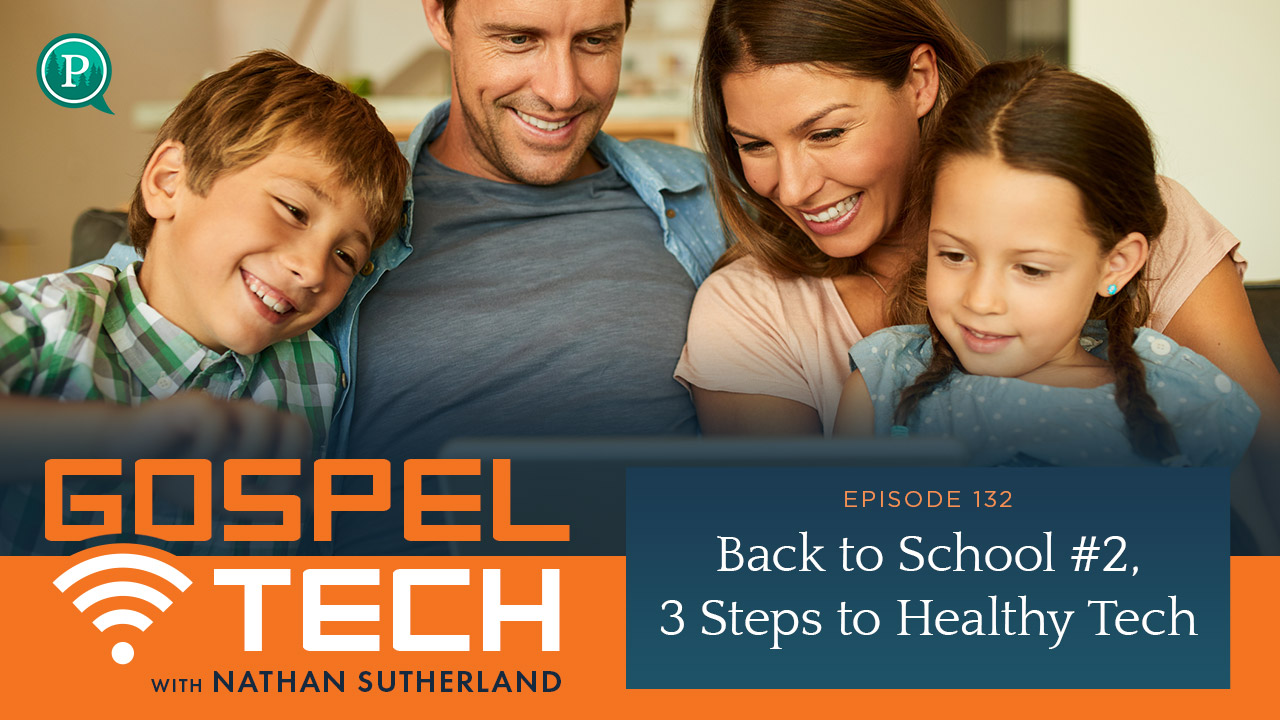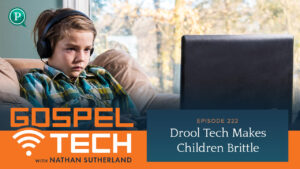2/3 parents say they believe it’s harder to parent now than it was 20 years ago, with many citing technology as their reason (Pew, Auxier et al, 2020). That feels about right. Parenting can feel downright overwhelming in this tech world!
Today we’ll discuss three steps we can all take to help ensure we have healthy tech as we take on the coming school year.
Show Links:
Gospel Tech
- Website | Instagram | Facebook | Twitter
- Andy Crouch Book: The Tech-Wise Family
- Bronson and Merryman’s Book: NurtureShock: New Thinking About Children
- Website: Protect Young Eyes
Transcription:
Purposely. Your life. God’s purpose. Listen at onpurposely.com.
Hello everyone. And welcome to the Gospel Tech podcast. The podcast dedicated to helping families love God and use tech. My name is Nathan Sutherland. I’m your host for today. I’m also the founder and CEO of Gospel Tech, and I’m so excited to have this conversation with you today.
Today is our second part of the Back-to-School series. We’re going to be talking about three steps for a back-to-school tech success. Today, we are going to be talking about one; how we can have a common space for tech. Two, how we can protect our sleep. And three, how we can have the tech talk with our children, what that looks like. We’ll have some practical steps to do that and walk away from this conversation with a clear eye towards, what we talked about last week, with tool tech, drool tech, and reset; and how to apply some of that in our daily practical life. Stuff that we can do today. That isn’t changed the entire way our family works. More than likely, unless we’re really coming from a different perspective, but more than likely it’s going to work right within what we’re already trying to do well and empower us to kind of get a couple more of those tech wins as we steadily ramp up towards that fall schedule. So, thank you for being here and with no further ado, let’s get this conversation started.
Welcome to the Gospel Tech podcast. A resource for parents who feel overwhelmed and outpaced as they raise healthy youth in a tech world. As an educator, parent, and tech user, I want to equip parents with the tools, resources, and confidence they need to raise kids who love God and use tech.
Thank you to everyone who has made this podcast possible. Thank you to those of you who have supported us. We have passed the 90% of our annual goal. Way over what we were hoping to do so far. So, thank you for being a part of that. If you want to still support, you can go GospelTech.net/donate. Thank you to those who are listening. We are noticing that apple podcast is where you guys are really enjoying, but some of you from Spotify, some of you from the purposely podcast, some of you from Gospel Tech.net/podcast. The reason I mention that is because as you share this with others, apparently, apple podcast is an easy way to listen to this podcast. So, you can go share that with others.
Another way for people to find us though through apps like the apple podcast, is by leaving us a review. It’s outta five stars. We ask that you leave us five stars, and if we’re not five-star material, you let me know; [email protected], I would love to improve. And a little one or two sentence statement of how we have helped you. You can simply say how it’s blessed you, how it’s encouraged you, one way that we’ve empowered you to parent in a tech world. That helps other people find us and use this resource and empowers them to love God and use tech. So, thank you for being a part of this process and helping us grow and reach more families with this resource.
Today’s conversation is, again, how we can have these three steps for back-to-school tech success. Number one, we’re jumping… oh no. Before we jump right in, I wanted to review again. I mentioned it in the intro, but last week, if you haven’t listened to the episode, it was talking specifically about the two types of tech and how we can know if tech is healthy.
So, we first define what we mean by tech. Tool tech helps us create. Drool tech, helps us consume. Again, last episode will run you through examples and some scenarios. So, you can kind of wrap your brain around that. It is very important and it’s an easy win as parents for us to then talk to our kids. Second is a reset, a little acronym that walks us through how we know of our tech use and our family’s tech use is healthy.
Using that information then, we’re going to get three wins for healthy tech at home, and a specifically tech success. I guess, broader picture because we’re starting with our home and talking about common space for tech. Okay. So, when we think about technology, this is true if we have five-year-olds. This is true if we have 15-year-old. We want our technology in a common space. The big win here is really what’s the focus of our family. We want to live intentionally. So, this isn’t simply putting a fence around technology and saying, well, technology is bad. And so, we need to control technology. And as long as we control tech, then everything else is good.
That leads us down a road of like, well, if I just never have a smartphone, if I just never have the internet, then I’ll be fine, which isn’t true. We’re at Gospel Tech here. So, I’m here to tell you your heart is broken, and without Jesus changing your heart, no amount of avoiding tech will make you magically good.
The Pharisees tried it. Jesus told them that’s not working for you. In more recent history, we’ve had a pair of world wars before the smartphone was invented. So, bad people still exist apart from technology. However, creating a common space for our technology has a number of benefits. One, it’s a visual reminder of what’s important to us. Clarity is important to us. Accountability is important to us. And the family unit is important to us. So, we’re going to have ourselves in a public space using public technology. Kids and parents are going to be doing this. It sets a good example for our kid, and it sets the tone for our house. This is where our technology stays. This is what our technology is for. It’s for helping us on that idea. Andy Crouch wrote a book called The Tech-Wise Family. And what I really like about it is it goes into this common space with technology idea. He challenges actually even further of what technology do we have in those common spaces?
His book is very approachable. It’s easy to engage, and yet it forces us to think more deeply about the technology we have. A simple question I like is in your family room, what is all the furniture point at? For many of us, it points to a television, and the question would simply be, “Is the television actually the focus of our family? Is that the thing that we want, all of that furniture?” There’s a lot of money that’s been put into pointing at something that also costs a lot of money. If it is, yeah. Sports are really important to us. News is really important to us. Movies are really important to us. Then that’s a good fit. And now, you know. You’ve asked the question.
For some of us, however, we go, you know what? It’s sort of like a thousand dollars paperweight. Maybe there’s another room for that. What else could I do? And it makes the common room conversation, a conversation. Rather than just an assumption. And I love that part. So, we can start with our children by modeling out this conversation and having this public space, this common space. Part of that conversation, we also are modeling this with our, not just our computers and laptops, but also our smartphones. And common space becomes like a protected space, both in our calendar and in our house. So, we have the Andy Crouch idea of like, what. Is technology to us? We’re going to make this comment space. So, we’re taking it out of our bedrooms. We’re also taking it away from our meals. And we are choosing a space in our house where this technology goes. So, our family laptop will be there, or computer, any iPads, and anything that has basically internet access is going to be here. And our smartphones are going to go there, because our smartphones, our tools that we use for communication and for work. And then when we are done with work, and we’re done with being away from the family and we’re home now, it’s now our chance to be present and to practice walking away from it. It’s not easy. I say practice because it is a discipline. This is not something I do perfectly. Because every little down moment, I start to have questions about what’s happening. That fear of missing out on something interesting, and then wanting that little thrill of a new bit of news, or a text from a friend, or that email from work; none of which has to be done right now.
I can easily say, Hey family, we’re going to eat dinner at, let’s say six o’clock. From 5:00 to 5:30, that’s people’s time to get on, and that’s when you can check social media. That’s when you can, whatever. Listen to that thing, watch that show. Like that can be your tech time. Or maybe it’s going to be after dinner. It needs to be with a way… Leave an hour until bedtime. So, if you’re in bed at nine, it can’t be after eight. But whatever that time is, you pick that window and that’s your time to get caught up on that. You’re going keep it as, Andy Crouch would say, keep it in its proper place. You’re going to go use it. And you’re going to walk away from it. And this again is creating common space. Not just the physical space where the technology’s going to stay, but the space in your calendar. The space in your day, where you go to tech, and you use it and then you leave. And anytime that starts to be a rub, we start to have the conversation. And we will talk about that later in this prep for technology, cuz there are people who are like, “Hey, I simply can’t in that amount of time, enjoy social media or enjoy this show or enjoy this game.” That’s going to be a conversation point. That’s a parenting opportunity coming through here. And when it’s our heart saying that, that’s an opportunity for us to go before the Lord.
So, that’s the, the idea behind the common space. And I would add to that common spaces are wonderful for accountability, it is hard to make bad decisions when other people are around you, and it’s harder to get away with them. So, we want to make bad decisions, difficult to make. Not because we somehow expect everyone to be perfect, just because technology is managed well, but because we love our family. And we love the Lord. And we want to make decisions that glorify him. So, accountability removes the live anonymity that we are not known online. That we can get away with this because there’s no one with us right now. We’re in reality, like there’s a trillion-dollar company watching your ever move because the device you’re using, and probably the browser you are using or the social media you’re on, and we have family members who love us. We want to bring those problems to the light.
All right, so, that’s common space. Number one, that’s our first step to success. The second is that we’re going to protect our sleep. So, part of, as I mentioned before, common spaces, we’re getting technology out of two areas. We’re removing it from mealtimes. So, we’re all fully present at meals. Smartphones and e-readers and all that stuff can go in a drawer. They can go in a box; you can choose your family’s method of doing this. My family simply puts ’em in a drawer. The reason for that being, they need to be out of sight. When you can see them, I won’t go into the research now, but there’s really interesting research even just on an academic level, but even behavioral psychology research on your brain, basically having to buffer the thought of grabbing your phone. So, you no longer, a hundred percent in the moment, you’re like 85% of the moment, with 10% of your brain fighting the 5% of your brain. That’s thinking about your phone on. So, you have this like loss of bandwidth as your brain is kind of chattering about the phone and all those little things. Right? All the texts and work and research and social media things, and all those little things that you’re now pushing out of your brain, take mental effort. So, put your phone out of sight so you can be present in your comment space.
That’s our first piece that ties into our second now, because we’re protecting sleep. I’ll start on why this is so important. So, if you read Bronson and Merryman’s book NurtureShock, came out in 2010, they say that less than eight hours of sleep doubles the likelihood of clinical depression. So, that’s really important. We also then know that simply using something like social media can also impact that twinge at all, did a 2017 study that showed using social media leaves us less satisfied with our own lives, feeling worse about ourselves, and feeling less connected with others.
We have research from people like Matthew Walker, who’s the director of the sleep in Neuroimaging lab at UC Berkeley in California. And his statement is that sleep impacts every area of life. Intelligence quotient, emotional quotient learning memory… literally every part of our lives that is important to us.
So, we want sleep. We then also need sleep. We want to protect it. The American Academy of Pediatrics actually agrees with this. Their quote is:
Technology should never interfere with a child’s sleep.
They’re not saying never use technology, but whatever the tech is, it should never interfere. Well, the reason that comes back to the bedroom is in 2014, Hershner and Shervin found that, and I quote,
Frequent use of technology before bed is associated with sleep difficulties and daytime sleepiness.
So, if we know that sleep is critical for our learning and emotional wellbeing, if we know that using technology before bed hurts our sleep, then it’s very logical to take the approach that the actual chief editor of Wired, former chief editor of Wired, had, which is there’s no screens in the bedroom period ever. So, then in New York times interview in 2014 and that’s, that’s a very good approach and the idea simply being, if it’s meant to be engaging, if it’s meant to be entertaining, if it’s meant to be fun, then we don’t want that in the same space where we’re trying to be sleepy. Because sleep is super, super, super important. At the end of the day, there’s zero evidence that says having tech in the bedroom is beneficial. And there are mountains of evidence even just in the last 10 years that is showing us that there is a lot of downsides to be had from having technology. Specifically drool tech in the bedroom.
So, what should we have in the bedroom? Well, One to have resources in the bedroom that support the purpose of the bedroom, which is going to be study, solitude, and sleep. So, have an alarm clock. You can go buy one on Amazon for like $8. It can be there tonight, or you can just go find one at a garage sale, depending on when you’re listening to this and where you live. But an alarm clock, a physical alarm clock, nobody needs a $1,000 alarm clock, which is what most of us argue for why we need our smartphone in our room. It is true. It’s a delightful alarm clock. Maybe when you go out for work trips or something, that is necessary. But I’m telling you, you don’t need that. The amount of downside of having that much distraction in your room with you is not worth the very minimal upside that has a very inexpensive fix. So, get an alarm clock. You can bring in something to beautify the space. You can have a plant, you can bring in blackout shade, so the light doesn’t disrupt you. Just a teeny bit of light can actually mess up a REM cycle, which is very important for your successful night of sleep.
You can bring in a study space. So, maybe you need a desk or a lamp or a, a giant bean bag. I don’t know, but by the way, the study space is going to be computer and smartphone free, for two reasons: one, practice. We need to work without our electronic devices sometimes. However, if it’s only school online, then that laptop can be in a public study space. And you don’t need that in the room, cuz that’s no longer one of the purposes of this bedroom. Cuz we’re keeping technology out of the room. Again, there are extenuating circumstances; online school with three siblings, right? Where you just run outta rooms. I get that. But we are talking, this is a sleep space. This is a solitude, and recovery space. This is a study space. Bookshelf storage, whatever you need to make this cozy, comfortable, restful, that is the purpose of the room. And that’s what we’re going to support because sleep is so critical. Because we love our children. And because we’re making a common space where our technology is available.
We’re going to set boundaries around it to help train our behavior, because much of drool tech, has another goal for us. It wants to take more of our time and our focus and our money than we plan on giving it. So, we put tech in its proper place, as Andy Crouch says. And we use it when we need it. And we walk away from it when we don’t. So, we’re going to get these tech wins by making a common space for our tech. Getting tech out of our meals, and out of our rooms. We’re going to make our rooms what they’re supposed to be. They’re going to be for study, for solitude, and for sleep.
And then we are going to have a tech talk with our kiddos. And this third point is huge. We’re going to address this more than once, but I think if I were to break it down here, the core, the crux really of the tech talk is to be calm. Right? Don’t freak out. I think when I think freak out. Okay. I won’t even, I won’t even address it there. Freak outs will come later. Don’t freak out. We’re going to be calm. Okay. Be cool. Mom and dad. Whether your kid is five or 15, the idea here is you’re simply saying, child of mine, I love. You can tell me anything and I’m not going to freak out. Right? You can tell me anything because I love you and I’m choosing to love you. Not because you’re perfect.
Okay? So, that needs to be said, if it needs to be that sentence, feel free to use that sentence. Son or daughter, right, child of mine, use their first name, I love you. You can tell me anything, cuz I’m on your team. They need to hear that from you. Even if you think, if it’s implied, even if you think you’ve said it too much on, if they’re not rolling their eyes, you haven’t said it enough. That’s a great quote from Chris McKenna of Protect Young Eyes. And I agree completely. If they’re not rolling their eyes, when you tell them that, keep saying it because they need to hear it more. They need to have that locked in as just a reflex. If mom and dad love me, I know I can go to them with this. And the reason for that is the three topics we need to address with them, again, as young as kindergarten, they need to hear some version of these three. They need to hear about mean people, the idea of bullies. That we need to be a friend we need to be, as Jesus shows us the neighbor to, yes, the victim who’s receiving that, but we also need to love the, the victimizer. That individual is very unhealthy. In fact, the likelihood that someone is a bully, it’s very likely they’ve been bullied. And so, you have the bullied, bullied aspect there. And they are 10 times more likely to suffer depression and self-harm than someone who has been bullied. So, when we see these kinds of chronic bullies in your brain, you can think back to that kid that was super mean to you. That individual was in a really sad space. we don’t have any healthy bullies. Zero. We have zero people who are bullies because they are well. Something’s always off. So, we need to get them the help they need, and we need to be there with the other person. With our younger children that can simply be a conversation of telling an adult. Ask the other kid if they’re okay. We need to get over this idea, like dare pitch to us when we were all kids, that we’re going to be the person to stand on the lunch table with like a Cape on point at that person and be like, you must stop. And instead, we just bore the shame of never stepping in and never helping. Instead, what we do know is that a simple note, a simple hand and reaching out means a lot to the kid who’s struggling. In fact, it can even undo a lot of the damage done through bullying. Is just having someone who knows your name and can ask if you’re okay. That’s really cool.
And we need support for that bully who needs the consequences in professional care, that comes with these kinds of chronic unhealthy and abusive behaviors. So, that can be a digital behavior. It can be in person. It can be a physical interaction. But we need to make sure that our kiddos know what they’re looking for. So, Hey, so, and so said, mean words… We tell an adult. We get this person. We go and check with this other person if they’re okay. Right. That’s all the intervention that we need from our younger children.
From our older children, similar. Right? We’re going to tell a caring adult. We are going to, a lot of social media apps have support for this. They actually are starting to help track this and monitor it so it can get reported to the group, whoever was hosting that platform. And then you can discuss as a family, what the next appropriate step looks like. Whether this is a space that’s helpful and helpful to be in, et cetera.
So, that’s the first thing we need to talk about. We need the idea that people can be mean. They can be mean on buses. They can be mean on the playground. They can be mean in class. They can be mean to teachers, in fact. And sometimes teachers can be the bullies. So, we need just the bigger conversation to be there, so that whatever comes up, we can be part of the conversation.
The second is strangers. Really tricky. Here’s two simple ways to deal with strangers. One, your child should know an adult should never seek help or friendship from a child. That’s a simple conversation. Okay. That if an adult approaches you, digitally or in person for friendship or aid, go tell an adult. You can do that in good faith, because you say, Hey, this is what we’ve told our children… an adult will never come to a child, and if they do, they really need help. So, come tell mommy and daddy so we can go help them. If they wanna be your friend, they really need a friend. Come tell mommy and daddy so we can be their friend. Now, sometimes being their friend means we’re going to get them professional care. That’s the friend loving thing to do, cuz that person’s very unhealthy sometimes. But it’s a very clean talking point that will allow us to address those people that may seem friendly and that we can’t help them… We’ll just freak ’em out. They don’t have the ability to know maybe what’s happening there.
And then on the people, their own age. We’re simply, we’re going to talk to people we know in real life online. We’re going to limit it to that. While there can be wonderful people that are amazing opportunities to meet, there’s also a lot more stories on the other side of apps and situations set up for failure where it’s people with more knowledge and more digital prowess taking advantage of people who don’t have it. So, we’re going to keep our relationships with people in real life. We’re going to build those relationships, and digital means can help that.
The third thing we are going to talk about is the unsafe and unkind images as young, again, as four and five, our kids need to know about this idea, as the book is titled good pictures and bad pictures. We, our children need to know that pictures that are unsafe and unkind. It actually, if you read the book, Good Picture Bad Picture, by Kristen Jensen and Debbie Fox, they do an awesome job in the advice they give. Simply tell your child this, there are pictures that will make you feel sad or weird, or there are pictures of people being unkind. And your actions are you say “No.” you turn away and you tell an adult. And the phrase you can say that I just encourage parents, just give ’em the sentences, “mom or dad when I was on the bus in the classroom at recess, on online, on your phone, I saw answer the blank,” and just have it be a factual statement. When they do that, you have promise you’re not going to freak out because you love them, and you’re going to help them process it.
This is very real. This has happened recently to a family friend who’s a pastor. He had a family come in and it was just two kids hanging out. They had this silly app that was supposed to connect you with someone else on the world and you could talk about common interests, and twice they did this right in a row, and both times was in an immediate inappropriate interaction. They shut it down. They told somebody. And now they’re processing it and that’s really healthy, but the shame and the damage there is still real. As well as just the anxiety that comes with now being online and wondering like, where will that come from?
So, while we’re giving our children access to these apps, access to the internet, they must be equipped with these conversational pieces, and the trust that’s going to allow them to bring that kind of brokenness to us. Sometimes they don’t do it on accidents. Sometimes it’s on purpose and yet they still feel shame, just like we do when we make mistakes on purpose. Just like Adam and Eve did, when they made a mistake on purpose. It was not out of ignorance that they ate the fruit. It was cuz they thought they knew better. And then they immediately felt terrible, and they hid from God. And yet God still loved them. And God said, I’m going to fix this. I’m going to send you a Redeemer. And I think as we wrap this conversation up, that’s what we need to be really keeping at the forefront of our minds.
We talk about success with our tech, going back to school. The conversation today wasn’t if you have perfect rules and you’ll have a perfect kid. Or if you just avoid enough technology, then your kid will be healthy and wise. Instead, what we’re doing, is we’re building a space and modeling for our children what healthy tech living looks like. Mealtimes are going to model relational health. Sleep is going to model intentional living and intentional healthy choices, that’s going to roll over to eating and go over to relationships and go over to those other things. We’re going to protect our sleep because everything we have in the world of science and research tells us we must, and that technology fights our sleep. So, that’s why we’re keeping outta the bedrooms as well.
And we’re going to have tech talks about mean people. Strangers and people that might be unsafe, without freaking our kids out. Without doing a whole like Dateline special, or 60 minutes. We’re just going to walk through what adult relationship with kids should be and how they can handle it. What kids’ relationships with kids should be. And then that third of unsafe pictures, because it’s an important conversation. We’re going to make ourselves a resource so we can get these parenting wins, because even in mistakes, that’s an opportunity for a parenting win. It’s an opportunity for us to extend the love of Jesus because think about how many people made mistakes around Jesus. Like he hung next to a convicted murderer. He had a woman of ill repute washing his hair, while he was being hosted by a self-righteous, huge jerk of a religious leader at the time, who didn’t even like wash his feet when he came in, which was customary. Who didn’t kiss him on the cheeks when he walked in, which was customary. It’s like inviting someone to your house and then refusing to shake their hand. So, in those situations, Jesus still extended love in the form of grace and truth. He valued them where they were at, and he shared with them the hope they had for redemption with their heavenly father. And that’s what we can do with our kiddos, wherever they’re at.
So, I hope this conversation is helpful and encouraging to you. I hope that it’s helped you see three things you can do to help prep for the school year. And I hope you will join us next week as we continue this conversation about how we can love God and use tech.







